Lightyears from sticking the landing.
Continue reading Star Wars: The Rise of Skywalker (2019) – Review
Continue reading Star Wars: The Rise of Skywalker (2019) – Review
‘I never had any friends later on like the ones I had when I was 12. Jesus, does anyone?’ We’re 33 years on from Stand By Me, yet its legacy continues to breathe. Muschietti’s first IT took heed of Stephen King’s affection for pure adolescence, reassembling his near-biblical horror odyssey into a lean coming-of-age fable; weaving the infectious familiarity of potty-mouthed liberty, Stranger Things-esque tone, and the inevitable loss of innocence.
Nostalgia was always Muschietti’s greatest enemy. King’s fiendish monster wasn’t a stranger to the screen: Tim Curry’s indelible turn in 1990’s otherwise dire mini-series birthed a multitude of generation’s phobias forevermore. But, as 2017’s first chapter opened on Georgie’s unfading, horrendous demise, it was clear the director knew his onions.
After seemingly defeating Pennywise, the child-eating clown (Bill Skarsgård) – with bats, chains and, of course, the power of friendship – the tweens of the Losers Club made a blood-oath to return if ‘it’ ever came back. IT Chapter Two fast-forwards 27 years later, and that promise is calling from the drains.
We’re reintroduced to Derry with true-to-life terror: as per the novel, the film begins with a teeth-crunching homophobic attack that does anything but skimp on acoustically sickening blows. The town’s rednecks detest gay men, but don’t expect further commentary on the US’ LGBT+ conflicts – it’s a medium for surface-level sickness, a reminder that nearly everyone outside the Losers is, basically, a villain, and a narrative tool. By one way or another, it spurs the re-emergence of the sewer’s frill-spangled beast – and he’s carrying an even harsher feasting ethic.
Meanwhile, the ragtag group of clown-killers are all grown-up. Bill (James McAvoy) is a successful author battling studios over screen adaptations of his work, constantly the butt of bad ending jokes (wink wink); Beverley (Jessica Chastain) has a successful career but is, again, ensnared in an abusive relationship; Ben (Jay Ryan) has shed the flab and transformed into a chiselled, high-flying architect; Richie (Bill Hader) has channelled his trash-mouth into stand-up comedy; Eddie (James Ransone) has cut a risk assessment vocation out of his hypochondriacal psyche and swapped out an anxiety-ridden mother for a (hilariously) similar wife; and there’s Stanley (Andy Bean), with a low-key, suburban lifestyle.
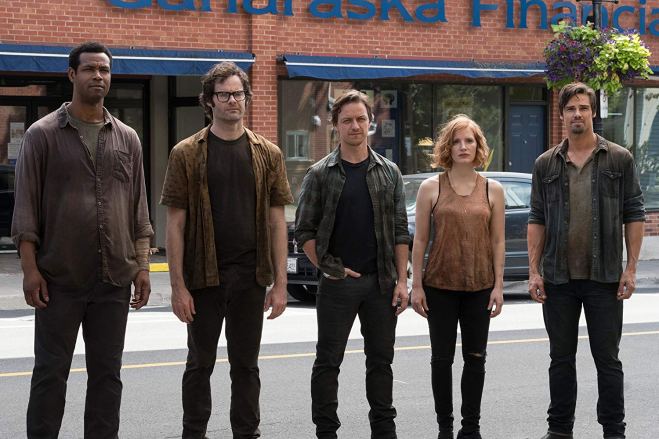
One Loser remains: Mike (Isaiah Mustafa). ‘Me? I never left… I remember all of it,’ he says. Clocking the return of ‘it’, he calls upon the group to cash in the oath and rally them to Derry. Excluding Mike, their recollections have mostly faded to a distant blur – although their unholy reunion causes a tidal wave of memory. Some moments welcomed, others packaged with nausea.
If the first chapter was about tackling the unknown, the sequel revolves around the aftershocks of trauma: while the Losers enjoy each other’s company upon meeting again, it’s evident they’re still harbouring past demons: one mention of the clown sends Eddie reaching for his inhaler, and Bill’s stutter clicks in. Beverley has the most tragic arc, going from her monstrous father to a (briefly seen) toxic husband where abuse is as frequent as a morning kiss. While her dad’s shadow lingers like a spectre, and despite a very strong performance from Chastain, her self-destruction isn’t entirely well-observed.
In translating King’s 1,138-page slab, Muschietti and screenwriter Gary Dauberman had wacky, sometimes repellent nonsense to trim: the giant turtle, the macroverse, and thank the lord, the sewer orgy. But some things remain: Henry Bowers’ presence is utterly pointless, there’s some creepy crawlies that echo The Thing‘s Lovecraftian scarily strange incarnations, and the romantic sub-plots. The ‘January embers’ latter bogs the film down; cutesy, yes, but predictable.
The group are better as a club than split up – though Hader’s Richie is a fiercely funny, rather heartbreaking force of nature. The quick-fire, sweary rapport as the Losers rekindle their loveable ticks over dinner, particularly between Richie and Eddie, manages to fleetingly bottle their former selves’ chemistry. Then, a major moment in the film sees the members split up (aptly pointed out as ‘fucking stupid’) to probe their buried teenage experience.
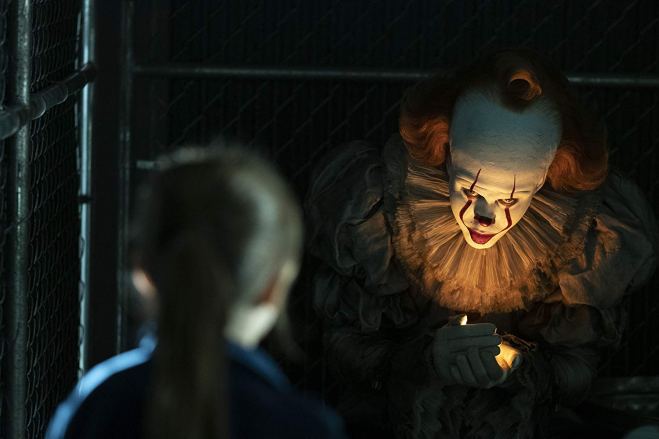
IT has always been psychological – the villain feeds on your fear – and Chapter Two establishes quickly that Pennywise isn’t just out to eat the adults; he wants to brutally torment them. In a string of rinse-and-repeat set-pieces (easily the film’s most tedious and runtime-pestering stretch), each individual Loser faces off with ‘it’ in some form while intersecting with flashbacks from their past selves: for example, Richie revisits an arcade where he was bullied, and Beverley makes a trip to her old home where an elderly woman now lives (a fixture of the sequel’s trailers). The de-aging technology on the kids is relatively seamless in these scenes, but the incessant reliance on them sees the film drag its feet from encounter-to-encounter.
McAvoy walks away with the movie’s best sequence; an frightening, dazzling funhouse (a nightmarish arena illuminated by Checco Varese, whose cinematography consistently blends vintage polaroid and wide, deliberately detailed framing), where Bill is desperately pursuing a young boy under the watchful drool of Pennywise (Skarsgård’s symbiotic relationship with the character should see him worshipped in the house of horror for years to come). This, and a baseball game munch, capture the very essence of what makes the clown so terrifying: its ruthlessness. The monster is at ITs best when there’s a horrid vulnerability: like Dennis Nedry’s demise at the hands of the dilophosaurus in Jurassic Park, that feeling of the clown whetting his appetite and moistening the child up with a mix of faux-security and ‘tasty, tasty, beautiful fear’ sends a shiver down your spine.
While lower-league child actors are offered up for the antagonist’s cravings throughout, the Losers are frustratingly protected by plot armour. On more than one reality-warping occasion, Pennywise proves that saying ‘it’s not real’ is no longer an adequate antidote to his transcendent onslaught; but he has very little agency in actually causing harm to the main cast – in return, the stakes are meagre and the scare-count is dreadfully scarce.
But the film’s horror elements are packaged in the mould of a fantastic adventure movie: like its Amblin-chasing predecessor, Chapter Two sees its grown-ups band together (under the leaping music of Benjamin Wallfisch’s classically fabulous composition) in the face of adversity to ‘kill this fucking clown’ – excellently delivered by Hader. ‘We are what we wish we could forget,’ the opening narration posits – to heal, we must recognise and conquer. For our Losers, childhood never reached a natural end, even as they broach their 40s – and while the boss battle succumbs to tiresome, modern CGI-trappings, the context of their fight remains steadfast.
Cameron Frew – @FrewFilm
Don Draper described nostalgia as “a twinge in your heart far more powerful than memory alone”. Tarantino’s vision of a pre-Manson, sun-kissed 60s Los Angeles – illustrated with Pan Am planes, Cadillacs and neon-lit cinema dusk-scapes – transcends the reality of your experiences and radiates like a warm memory, creating a tangible sense of place that’s every bit authentic as it is irresistible. Like Scorsese’s titular twinkly Casino, QT’s city of angels is an alluring character of its own.
The filmmaker’s legacy is a complex menagerie of violent, sweary concoctions: among them is the ultra-nihilism of The Hateful Eight; the jet-black, scalped revisionism of Inglorious Basterds; the ode to Grindhouse exploitation of Death Proof; and the superfly pithiness of Reservoir Dogs. He’s famously proclaimed he’ll only make 10 films; which makes Once Upon a Time in Hollywood his ninth (counting Kill Bill as one bloody affair).
Though, contrasting expectations as his filmography draws to a close, his penultimate release doesn’t write history with lightning in Pulp (semi-)Fiction. For much of its 161-minute runtime, it’s closer in spirit to Jackie Brown; still layered with Tarantinoisms – freeze frame flashback exposition à la Hugo Stiglitz, snazzy editing and infectious tunes (particularly Los Bravos’ Bring a Little Lovin’) – but much mellower, allowing every little thread to untangle at a leisurely, captivating pace.
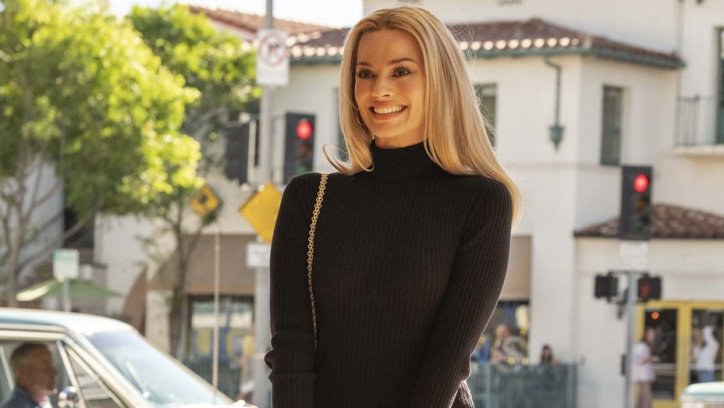
We open with a reel of Bounty Law, an amusingly corny western TV show, before cutting to an interview with our leads: Rick Dalton (Leonardo DiCaprio), a jading television actor; and his stunt-double Cliff Booth (Brad Pitt), who helps “carry Rick’s load”. Rick is floundering in a youthful arena; as his agent warns him (Al Pacino in a cameo powered by legend-casting), he’s playing the bad guy so the good guys can run in the industry, coming “face to face with he failure” of his career as he averts change.
Cliff on the other hand plays fiddle to Rick’s lifestyle. Without a gig next to his double, he’s yang without ying. He drives him around, picks him up, fixes his aerial – though it isn’t begrudged. The pair share a brotherly bond; while Rick’s actions may appear selfish, Cliff’s puppy-like eagerness makes their rapport particularly charming as they traverse their respective tales.
The film takes place over the course of 1969, placing up-and-coming starlet Sharon Tate (Margot Robbie) in their orbit, living next door to Rick with world-renowned director Roman Polanski (Rafal Zawierucha). The Bryan Adams timestamp is no secret coincidence; the Manson family pervade frames as Rick and Cliff cruise around, dead behind the eyes and endlessly hitchhiking back to Charles (Damon Herriman). The presence of the cult (who infamously slaughtered Sharon Tate and four others) is more of a lingering reminder of the (seemingly) inevitable than an examination from the director; perturbing the almost wistful essence that makes much of the picture feel like a reverie.
There’s a certain poeticism to OUATIH. Robert Richardson’s cinematography is beautifully textured and composed, feeling more of a tool to establish a world you’d roam than the wall-worthy pizazz of The Hateful Eight and Kill Bill. There’s no major takeaway moment of screenwriting genius like Jules’ recital of Ezekiel 25:17. Nor is there much of a plot at all – while Django Unchained‘s narrative path is rather traditional compared to Pulp Fiction‘s vastly different, groundbreaking spliced storytelling, the filmmaker’s latest flows through the trio’s vignettes like an epic rhapsody.
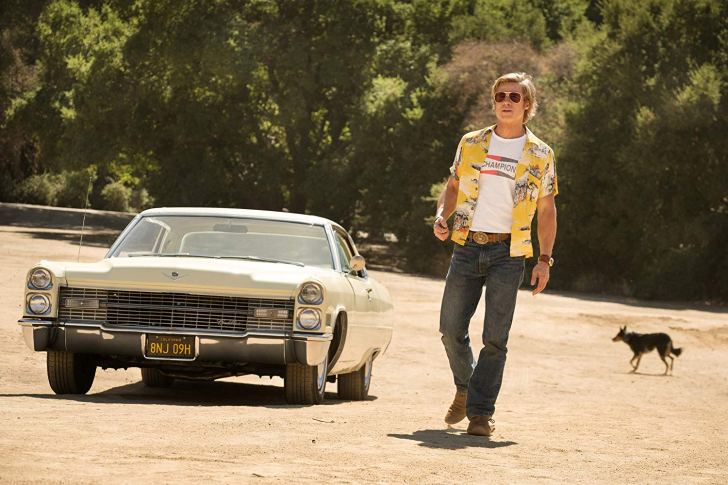
It’s Tarantino at his most personal. He’s crafted an immense love letter; not to racial slurs, not to feet (even though there are many, and they’re all dirty), but to the movies. Robbie’s Tate is a vessel for his addiction to the ecstasy of Hollywood – she’s an utterly joyous presence, glamorous and grin-inducing (particularly in a scene where she charms her way into a free screening of her own film, The Wrecking Crew, lapping up the audience’s reactions as she sits wide-eyed in pride).
Pitt’s Cliff embodies the problematic essence of Tarantino’s best characters, now entering his pantheon of icons. It’s an exceptional turn, one layered in stud charisma that straddles you from the off. He’s what Stuntman Mike imagines he is – take a concoction of him, True Romance‘s Floyd and Inglorious Basterds‘ Aldo, and you have Cliff. Whereas DiCaprio’s Rick is more delicate; an actor losing his feet and forever battling his own – frequently weepy – insecurities. One could read him as a representation of QT’s post-Death Proof emotional state (disheartened by the sedated critical and audience response). His first lead role since The Revenant could see him win another Oscar – though often played for laughs, the actor never forgets to imbue despair with genuine, poignant pathos.
Tones diverge without pattern; you have a hilariously silly, albeit very brief, tussle with Bruce Lee one moment, then an arse-clenching, suspense-knitted trip to the Manson family’s Spahn Ranch the next. As you hurtle towards the film’s show-stopping conclusion (smartly spawned from a meta-commentary on the violence debate), the underlying dread releases. The result is an explosion of exhilarating bloodlust that only Tarantino could orchestrate – audiences will laugh, scream and cheer till the credits roll. Also, there’s an amazing dog.
Cameron Frew – @FrewFilm
Continue reading Fast and Furious: Hobbs & Shaw (2019) – Review
Toy Story is a cinema landmark. A turn-of-the-tide in computer animation, a blissful injection of universal jollity, and the beginning of one of film’s greatest trilogies. The road to Toy Story 4 has been one of paranoia; the third entry tied up everything in a heart-wrenching bow, so what’s the point? As the cloud-laden blue sky appears once again, with Randy Newman’s happy-go-lucky Western score, the real question is: why did we ever doubt Pixar?
Childhood attachment is a fickle thing; the initial resistance towards this fourthquel is an interesting parallel to the series’ themes. If anyone was fit for the task, it’s Josh Cooley; one of the minds behind the studio’s brilliant Inside Out. Though in helming this unexpected continuation, he’s stripped the ensemble feel; honing in on an intimate reflection of one’s wants, needs, past and fate.
We start nine years in the past, in the silhouette-begging rainfall of night. We’re still in the world of Andy, with an eclectic gathering of toys in tow. It’s a complete sugar-rush; igniting that childhood love with some a-class plaything action, bidding to rescue RC from the monsoon. Soon, we’re thrown back to the past, with Bonnie – the sweet little girl to whom Andy passed the mantle post-incinerator.
Woody (Tom Hanks), the ever-protective sheriff, is desperate to make sure Bonnie is okay on her first day of kindergarten, but soon finds himself saddled with Forky (Tony Hale) – a day-one craft construction of goggly eyes, tack and a spork. Above all else, he’s a toy; one with an identity crisis, a fear of himself and love for trash (his self-loathing is intensely relatable). Woody’s attempts at babysitting go awry near a fairground, where Forky escapes, setting of a chain of hilarious, sometimes frightening events.
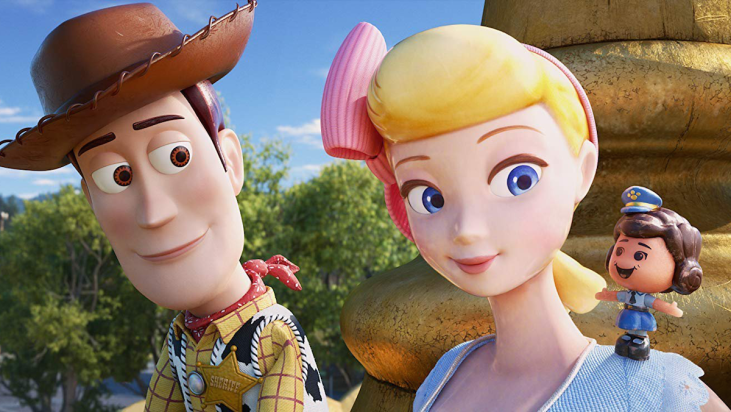
In truth, there are similarities to Toy Story 3; the single location set-up is very Sunnyside, and yes there are toys who resent their past owners. But Cooley plays it out much differently. Instead of divvying up tasks, Buzz (Tim Allen), Jessie (Joan Cusack) and co. are rather sidelined; utensils in serving Woody’s plight and popping in for some gags and emotional moments.
It’s quite effective; Hanks has never been better as Woody, feeling truly human rather than merely anthropomorphic, battling his in-built addiction to keep his owner happy – a fact of ‘life’ that seems impossible to overcome. Of course, there’s another key figure in this tale: Bo Peep (Annie Potts). Making a return as a Rey-inspired wasteland warrior, with a shining polish and terrific self-assurance, she and Woody turn Toy Story 4 into an unexpected, but dizzyingly engrossing love story – think Before Sunset, but plastic and porcelain.
This, plus a refreshingly realised, un-twisty antagonist (voiced by Christina Hendricks) with a Dead Silence-esque team of terrifying dummies, and two new wicked fluffballs, Ducky and Bunny, in the form of Key and Peele, with a madcap, deranged sense of humour and boundless energy, give way to a plentiful supply of gut-bursting laughs. You won’t forget Keanu Reeves as Duke Caboom (!), a Canadian stuntman toy with a dazzling aptitude for posing (and saying “Kaboom” better than anyone on the face of the earth). The screenplay from Andrew Stanton and Stephany Folsom is arguably the funniest of the lot.
The inevitable perils do become a little repetitive (always a danger of a movie in one place) but the joy that propels stops it from grating. One thing’s for sure; it’s a stunner to look at. Meticulously rendered, finite reflections and mind-boggling detail considered from the most inconsequential of moments to soaring landscapes bursting with Coco-esque colour (there’s even a blink-and-you’ll-miss-it animated split diopter) – as an overall package, cosmetically, you cannot do any better.
Then comes the kick in the balls of your heart. Some say it’s unnecessary; I say it’s bang-on-the-money. As has been the case before, the film delves deeper into areas we never knew existed, explored themes audiences never anticipated, and manages to make adults and kids alike weep like they’ve never weeped. Kids: put down the phones, grab a toy, make a story.
Cameron Frew – @FrewFilm